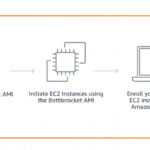Blockchain (the company) lets you borrow USD PAX against collateral
What do you do when you’re rich in cryptocurrencies but you don’t want to sell your positions? The company named Blockchain thinks it has found a solution. It lets you borrow money against cryptocurrencies held in your Blockchain wallet.
As soon as you lock cryptocurrencies in your wallet, you receive USD PAX, a stablecoin that is pegged against USD. You can then convert, send and do whatever you want with your stablecoins. You can pay back your loan whenever you want.
The minimum loan size is $1,000 and Blockchain requires a collateralization ratio of 200%. It means that if you want to borrow $5,000, you need to put down the equivalent of $10,000 in cryptocurrencies as collateral.
Blockchain charges interest on loans. Your interest rate may vary but the company tries to be transparent about it before you accept the loan. By default, Blockchain uses your collateral to collect interest. Be careful with the value of your cryptocurrencies, as your collateral could end up losing a ton of value even though you still owe USD.
Behind the scene, Blockchain is running a lending desk for institutional investors. The company launched this feature back in August. Blockchain thinks that it has built a strong liquidity pool that it can leverage with retail investors.
Users in the U.S., Canada and the U.K. are not eligible to the feature for now. Blockchain only accepts collateral in BTC for now.

Powered by WPeMatico
Alma is a Klarna-like payment startup that lets you buy now and pay later
Meet Alma, a French startup that helps you offer a new payment option for your expensive goods. Like Klarna, clients can choose to pay over three or four installments. But the comparison stops here, as Klarna isn’t available in France. Alma just raised a $14.1 million (€12.5 million) funding round.
Idinvest, ISAI and Picus Capital are investing in today’s funding round. Additionally, Alma has opened a $19.2 million (€17 million) credit line to finance merchant payments.
As a merchant, when you integrate Alma in your payment flow, your customers can choose Alma to make it less intimidating. Instead of getting charged when you pay, you can choose to buy now and pay over three or four installments. Merchants get paid instantly.
“We handle risk and cash advance in house,” co-founder and CEO Louis Chatriot told me. “When it comes to the risk of non-payment, we have implemented a series of verifications, filters and algorithms in order to detect fraud and high-risk profiles.”
The company creates multiple categories depending on your profile. It can ask for more information if Alma has some doubts, such as API access to your bank statement. Assessing risk is particularly difficult in France, as there’s no central credit scoring system.
Merchants can choose to pay the processing fees in full — 3.8% of the transaction for a payment in three intallments, 4.2% for a payment in four installments. But they also can share the processing fees with the end customer.
Alma is compatible with most e-commerce platforms, such as Shopify, Magento and Prestashop. Merchants can also offer Alma as a payment option in retail stores.
Over 1,000 merchants are using Alma already — the startup processes tens of millions of euros of transactions per year. Clients include Bobbies, Asphalte, Cowboy, Weebot, The Cool Republic and The Socialite Family.
With today’s funding round, the company wants to attract more merchants and launch two new payment options — pay later and a more traditional option to pay now. In addition to that, Alma currently redirects customers to its own checkout page. The startup wants to integrate its payment widget directly on e-commerce websites.
Powered by WPeMatico
Visual One smartens up home security cameras with object and action recognition
“Smart” cameras are to be found in millions of homes, but the truth is they’re not all that smart. Facial recognition and motion detection are their main tricks… but what if you want to know if the dog jumped on the couch, or if your toddler is playing with the stove? Visual One equips cameras with the intellect to understand a bit more of the world and give you more granular — and important — information.
Founder Mohammad Rafiee said that the idea came to him after he got a puppy (Zula) and was dissatisfied with the options he had for monitoring her activities while he was away. Here she is doing what dogs do best:

There are no bad dogs, but chairs are for people
“There were specific things I wanted to know were happening, like I wanted to check if the dog got picked up by the dog walker. The cameras’ motion detection is useless — she’s always moving,” he lamented. “In fact, with a lot of these cameras, just a change in the lighting or wind or rain can trigger the motion alert, so it’s completely impractical.”
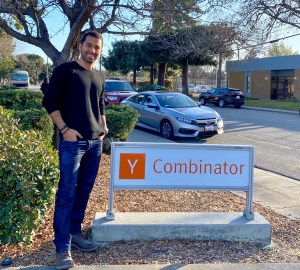 “My background is in machine learning. I was thinking about it, and realized we’re at a stage where this problem is starting to become solvable,” he continued.
“My background is in machine learning. I was thinking about it, and realized we’re at a stage where this problem is starting to become solvable,” he continued.
Some tasks in computer vision, indeed, are as good as solved — detecting faces and common objects such as cars and bikes can be done quickly and efficiently. But that’s not always useful — what’s the point of knowing someone rode their bike past your house? In order for this to have value, the objects need to be understood as part of a greater context, and that’s what Rafiee and Visual One are undertaking.
Unfortunately, it’s far from easy — or else everyone would be doing it already. Identifying a cat is simple, and identifying a table is simple, but identifying a cat on a table is surprisingly hard.
“It’s a very difficult problem. So we’re breaking it down to things we can solve right now, then building on that,” Rafiee explained. “With deep learning techniques we can identify different objects, and we build models on top of those to specify different interactions, or specific objects being in specific locations. Like a car in the wrong spot, or a dog getting on a couch. We can recognize that with high accuracy right now — we have a list of supported objects and models that we’re expanding.”

In case you’re not convinced that the capabilities are that much advanced from the usual “activity in the living room” or “Kendra is at the front door” notifications, here are a few situations that Visual One is set up to detect:
- Kid playing with the stove
- Toddler climbing furniture
- Kid holding a knife
- Baby left alone for too long
- Raccoon getting into garbage
- Elderly person taking her medications
- Elderly person in bed for too long
- Car parked in the wrong spot
- Garage door left open
- Dog chewing on a shoe
- Cat scratching the furniture
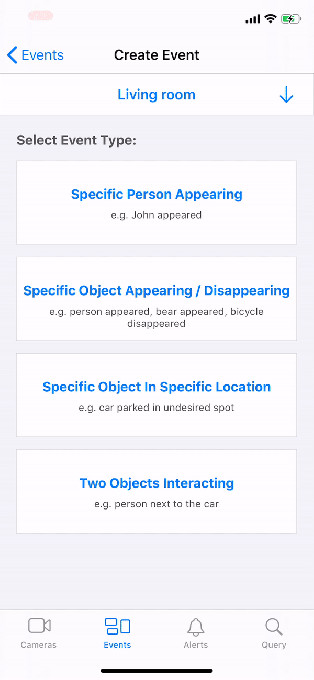
The process for creating these triggers is pretty straightforward
If one of those doesn’t make you think “actually… that would be really good to know,” then perhaps a basic security camera is enough for your purposes after all. Not everyone has a knife-curious toddler. But those of you who do are probably scrolling furiously past this paragraph looking for where to buy one of these things.
Unfortunately Visual One isn’t something you can just install on any old existing system — with the prominent exception of Nest, into which it can plug. Camera workflows are generally too locked down for security and privacy purposes to allow for third-party apps and services to be slipped in. But the company isn’t trying to bankrupt everyone with an ultra-luxury offering. It’s using off-the-shelf cameras from Wyze and loading them with its own software stack.
Rafiee said he pictures Visual One as a mid-tier option for people who want to have more than a basic camera setup but aren’t convinced by the more expensive plays. That way the company avoids going head-on with commodity hardware’s race to the bottom or the brand warfare taking place between Google and Amazon’s Nest and Ring. Cameras cost $30-$40, and the service is $7 per month currently.
Ultimately the low-end companies may want to license from Visual One, while the high-end companies will be developing their own full stack at great cost, making it difficult for them to go downmarket. “Hardware is hard, and AI is specialized — unless you’re a giant company it’s hard to do both. I think we can fill the gap in the market for mid-market companies without those resources,” he said.
Of course privacy is paramount as well, and Rafiee said that because of the way their system works, although the AI lives in the cloud and therefore requires the cameras to be online (like most others), no important user data needs to be or will be stored on Visual One servers. “We do inference in the cloud so we can be hardware agnostic, but we don’t need to store any data. So we don’t add any risk,” he said.
Visual One is launching today (after a stint in YC’s latest cohort) with an initial set of objects and interactions, and will continue developing more as it observes which use cases prove popular and effective.
Powered by WPeMatico
Assembled raises $3.1M led by Stripe to build ‘the operating system for support teams’
CRM software accounts for one-quarter of all enterprise IT spend. But ironically, while a lot of money is spent on platforms like Salesforce or SAP to manage incoming calls and outgoing marketing and sales activity, not a lot of attention is given to the issue of how to help the teams using all that software work better.
What are the peak times for calls? What are the most common questions? Which staff are best skilled at what kinds of questions? And who is actually working at any given time? These are just some of the issues, but in many cases, there isn’t much in the way of tools used to help with these at all — organisations often just hack a spreadsheet platform like Google Sheets or a calendar app to get by, or do nothing at all.
Today, a startup called Assembled is coming out of stealth mode to address that gap in the market, with a platform that’s built specifically to address the kinds of questions and issues that customer support teams encounter and — answered well — can help them work much better.
Out of the gate, Assembled is announcing $3.1 million in seed funding led by Stripe — where the founding team previously worked — with participation also from Basis Set Ventures, Signalfire and several angel investors (who are also mostly former Stripe employees).
Assembled’s longer-term ambition is to build tools for what co-founder Ryan Wang describes as “the logistics of customer support.”
“We want to become the operating system for support teams,” he said. Most immediately, the company’s focus will be on agent performance. “Teams want to learn about their top performers and how they spend their time, and offer data to empower their decision-making.”
Stripe — the payments and related services provider that is now valued at $35 billion — has developed a sizable operation funding startups adjacent to its own interests in cultivating relationships with startups and other smaller businesses. You could consider it a strategic investor in Assembled: alongside Grammarly, Gofundme, Hopper and Harry’s, Stripe is one of Assembled’s marquee customers.
Wang, an ex-Stripe engineer who co-founded Assembled with his brother John and Assembled’s CEO Brian Sze (both also ex-Stripe), said in an interview that the idea for the startup came directly out of the pair’s experiences as early employees at Stripe.
The approach at the startup in its early days was very grass-roots: employees would get together outside the office to go through support tickets as a way of identifying trends and to talk through them to figure out what might need fixing, how to handle issues in the future and so on.
It was probably a great way for the team to really stay in touch with what customers needed and wanted. But eventually this approach presented a problem: How do you scale this kind of process? To a tech person, the solution would be obvious: build a platform that can help you do this.
“Within the landscape of CRM, we could see that tech hadn’t really been applied to the business of supporting customer support,” Wang said. “That is why we left. We’d understood that it was a broad problem.”
A tool to help improve workforce management for customer support teams is a no-brainer for a company already trying to address these issues through its own home-baked solutions. Wang noted that one of its current customers had built out such an extensive map of data on Google Sheets trying to address customer support workforce management that “they broke Google Sheets. It was just too big.”
Indeed, Bob van Winden, Stripe’s head of operations, noted: “Millions of businesses rely on Stripe every day. To support them, we obsess over every detail of delivering fast, reliable customer service, including free 24×7 phone and chat support. This led us to Assembled, which our global support teams are using to stay coordinated and focused on helping Stripe’s users thrive.”
Less obvious is the use case when a company has never identified these issues, or sees them but haven’t made efforts to try to solve them because it seems too difficult. (The classic issues here are that Assembled is “too clever by half,” or “too ahead of its time.”) That presents both an open market for Assembled, but also a greenfield challenge.
One route to customers has been to integrate with more established CRM packages. Currently Assembled integrates with Salesforce, Kustomer and Zendesk, so that it can source data from these to provide more insights to users.
Another is to provide a set of tools that speak to the wider trend for analytics and data-based insights that can be used to improve how a company works. Indeed, just as Kustomer has disrupted the idea of a CRM being focused on a narrow funnel of inbound requests, Assembled also is rethinking how to parse data to figure out what a customer support person should be doing and when.
The startup provides a way to forecast inbound support query volumes, and to map that into staffing plans that cover multiple channels like chat, email, phone and social media. The staffing plan, in turn, also acts as a scheduling tool to set up group and single calendars for individuals.
A team’s activity, meanwhile, is tracked through a set of metrics the whole team can see and use to calibrate their work better.
Going forward, you can imagine Assembled expanding in a couple of different directions. One might be to offer workforce management to more teams beyond customer support, but that also have to work out how to manage inbound requests and turn them into more efficient work plans. Another might be to continue expanding the kinds of tools it might provide to customer support teams to continue complementing basic CRMs, in particular as customer support comes to mean different things, depending on who the “customer” actually is.
“We see the term ‘customer support’ evolving,” Wang said. “The big struggle is what the encompassing term should be instead. Generally, our view is that we want to transform and elevate what customer support means. It’s not just about call centers, but any drivers of customer experience related to your products.”
Powered by WPeMatico
AWS launches Bottlerocket, a Linux-based OS for container hosting
AWS has launched its own open-source operating system for running containers on both virtual machines and bare metal hosts. Bottlerocket, as the new OS is called, is basically a stripped-down Linux distribution that’s akin to projects like CoreOS’s now-defunct Container Linux and Google’s container-optimized OS. The OS is currently in its developer preview phase, but you can test it as an Amazon Machine Image for EC2 (and by extension, under Amazon EKS, too).
As AWS chief evangelist Jeff Barr notes in his announcement, Bottlerocket supports Docker images and images that conform to the Open Container Initiative image format, which means it’ll basically run all Linux-based containers you can throw at it.
One feature that makes Bottlerocket stand out is that it does away with a package-based update system. Instead, it uses an image-based model that, as Barr notes, “allows for a rapid & complete rollback if necessary.” The idea here is that this makes updates easier. At the core of this update process is “The Update Framework,” an open-source project hosted by the Cloud Native Computing Foundation.
AWS says it will provide three years of support (after General Availability) for its own builds of Bottlerocket. As of now, the project is very much focused on AWS, of course, but the code is available on GitHub and chances are we will see others expand on AWS’ work.
 The company is launching the project in cooperation with a number of partners, including Alcide, Armory, CrowdStrike, Datadog, New Relic, Sysdig, Tigera, Trend Micro and Waveworks.
The company is launching the project in cooperation with a number of partners, including Alcide, Armory, CrowdStrike, Datadog, New Relic, Sysdig, Tigera, Trend Micro and Waveworks.
“Container-optimized operating systems will give dev teams the additional speed and efficiency to run higher throughput workloads with better security and uptime,” said Michael Gerstenhaber, director of Product Management at Datadog.” We are excited to work with AWS on Bottlerocket, so that as customers take advantage of the increased scale they can continue to monitor these ephemeral environments with confidence.”
Powered by WPeMatico
E3 is the latest conference shuttered over COVID-19 concerns
Another major tech show has fallen victim to COVID-19 concerns. Rumors around E3’s cancellation began swirling last night, with a number of publications reporting from sources close to the show.
The governing body, the Entertainment Software Association, made the news official. In a statement provided to TechCrunch, the ESA noted:
After careful consultation with our member companies regarding the health and safety of everyone in our industry – our fans, our employees, our exhibitors and our longtime E3 partners – we have made the difficult decision to cancel E3 2020, scheduled for June 9-11 in Los Angeles.
Following increased and overwhelming concerns about the COVID-19 virus, we felt this was the best way to proceed during such an unprecedented global situation. We are very disappointed that we are unable to hold this event for our fans and supporters. But we know it’s the right decision based on the information we have today.
Our team will be reaching out directly to exhibitors and attendees with information about providing full refunds.
Held in Los Angeles during the summer, E3 continues to be one of the world’s premier gaming shows. But struggles roughly a decade ago found the event transforming into a far leaner trade show, opening the doors to a number of competitors in the process. It has managed to rebound to some degree, thanks in part to the decision to open its doors to the gaming public, E3’s bottom line. The move to cancel could ultimately have a profound effect on the show’s future, moving forward.
Even with Sony’s decision to skip the show being announced back in January, 2020 was shaping up to be a big year for the event, with next-generation versions of both the PlayStation and Xbox due out by year’s end.
E3 is just the latest in a long line of tech shows that have closed up shop for the year, beginning with Mobile World Congress last month. Likely many will following Nintendo’s longstanding tradition of making announcements via webcast. The question for E3’s organizers is whether those companies who move to an online approach will ultimately return in 2021.
The ESA is “exploring options” around offering elements of the event online.
Powered by WPeMatico
European lawmakers propose a ‘right to repair’ for mobiles and laptops
The European Commission has set out a plan to move towards a ‘right to repair’ for electronics devices, such as mobile phones, tablets and laptops.
More generally it wants to restrict single-use products, tackle “premature obsolescence” and ban the destruction of unsold durable goods — in order to make sustainable products the norm.
The proposals are part of a circular economy action plan that’s intended to deliver on a Commission pledge to transition the bloc to carbon neutrality by 2050.
By extending the lifespan of products, via measures which target design and production to encourage repair, reuse and recycling, the policy push aims to reduce resource use and shrink the environmental impact of buying and selling stuff.
The Commission also wants to arm EU consumers with reliable information about reparability and durability — to empower them to make greener product choices.
“Today, our economy is still mostly linear, with only 12% of secondary materials and resources being brought back into the economy,” said EVP Frans Timmermans in a statement. “Many products break down too easily, cannot be reused, repaired or recycled, or are made for single use only. There is a huge potential to be exploited both for businesses and consumers. With today’s plan we launch action to transform the way products are made and empower consumers to make sustainable choices for their own benefit and that of the environment.”
The Commission said electronics and ICT will be a priority area for implementing a right to repair, via planned expansion of the Ecodesign Directive — which currently sets energy efficiency standards for devices such as washing machines.
Its action plan proposes setting up a ‘Circular Electronics Initiative’ to promote longer product lifetimes through reusability and reparability as well as “upgradeability” of components and software to avoid premature obsolescence.
The Commission is also planning new regulatory measures on chargers for mobile phones and similar devices. While an EU-wide take back scheme to return or sell back old mobile phones, tablets and chargers is being considered.
Back in January the EU Parliament voted overwhelmingly for tougher action to reduce e-waste, calling for the Commission to come up with beefed up rules by this summer.
In recent years MEPs have also pushed for the Ecodesign Direction to be expanded to include repairability.
The Commission proposals also include a new regulatory framework for batteries and vehicles — including measures to improve the collection and recycling rates of batteries and ensure the recovery of valuable materials. Plus there’s a proposal to revise the rules on end-of-life vehicles to improve recycling efficiency and waste oil treatment.
It’s also planning measures to set targets to shrink the amount of packaging being produced, with the aim of making all packaging reusable or recyclable in an economically viable way by 2030.
Mandatory requirements on recycled content for plastics used in areas such as packaging, construction materials and vehicles is another proposal.
Other priority areas for promoting circularity and reducing high consumption rates include construction, textiles and food.
The Commission expects the circular economy to have net positive benefits in terms of GDP growth and jobs’ creation across the bloc — suggesting measures to boost sustainability will increase the EU’s GDP by an additional 0.5% by 2030 and create around 700,000 new jobs.
The backing of MEPs in the European Parliament and EU Member States will be necessary if the Commission proposals are to make it into pan-EU law.
Should they do so, Dutch social enterprise Fairphone shows a glimpse of what’s coming down the repairable pipe in future…
Powered by WPeMatico
Libra rival Celo launches 50-member Alliance For Prosperity
Some Libra Association members like Andreessen Horowitz and Coinbase Ventures are double-dipping, backing a competing cryptocurrency developer platform. Launching today with over 50 partners, non-profit The Celo Foundation’s ‘Alliance For Prosperity’ offers a way for developers to build decentralized mobile apps that are based on Celo’s blockchain platform and USD stablecoin.
The open-source Celo platform is still in testing with plans to officially launch its mainnet in April. The non-profit founded in 2017 has raised $36.4 million, including its Series A where Andreessen Horowitz’s a16z Crypto bought $15 million worth of Celo Gold tokens.

The biggest differentiator of Celo’s network versus other blockchains is that payments in the Celo Dollar stablecoin can be sent to people’s phone numbers rather than complicated addresses. The goal is to make delivering utility via blockchain easier by building a flexible network of applications that doesn’t scare regulators like Libra has.
The Alliance For Prosperity includes Andreessen Horowitz (which funded Celo), Coinbase (Ventures), Bison Trails, Anchorage, and Mercy Corps — all of which are also Libra Association members. That could potentially create a conflict of interest regarding which cryptocurrency and developer platform they promote to their portfolio companies, integrate into their products, or focus on for delivering financial services to the needy.
Other high-profile Alliance partners include Carbon, GiveDirectly, Grameen Foundation, Maple, and Polychain. Partners have made a somewhat vague commitment to “backing development efforts of the project, building infrastructure, implementing desired use cases on the platform, integrating Celo assets in their projects, or collaborating on education campaigns in their communities to further advance the use of blockchain technology” according to Chuck Kimble, Celo’s cLabs head of business development and head of the Alliance. Anyone can apply to join the open network, and there’s no minimum financial investment like Libra’s $10 million prerequisite.

Celo isn’t trying to replace the dollar with its own synthetic currency, and its reserve is backed with other cryptocurrencies rather than fiat cash. That might make it more acceptable to regulators who were worried that Libra’s token and fiat currency bundle-backed reserve could impact the global financial system. The first of the decentralized apps on the platform, the Celo Wallet, is already available for iOS and Android.

Like many blockchain projects, there are some lofty intentions for social impact with Celo. Use cases include “powering mobile and online work, enabling faster and affordable remittances, reducing the operational complexities of delivering humanitarian aid, facilitating payments, and enabling microlending” says Kimble. The real driver of this potential is Celo’s promise of much lower transaction fees than traditional middlemen charge.
When asked what the biggest threats to Celo’s success are, he told me “Banking infrastructure improving faster than we expect” and “Mobile adoption or LTE data not expanding on their current trajectory.” He did not mention the developer fatigue, regulatory scrutiny, technical complexity, or slow adoption of blockchain utilities that have plagued other crypto for good projects.
Here’s the full list of members working towards these goals:
Abra, Alice, AlphaWallet, Anchorage, Appen, Ayannah, Andreessen Horowitz, B12, BC4NB (Blockchain for the Next Billion), BeamAndGo, Bidali, Bison Trails, Blockchain Academy Mexico, Blockchain.com, Blockchain for Humanity (b4h), Blockchain for Social Impact (BSIC), Blockdaemon, Carbon, cLabs, CloudWalk Inc, Cobru, Coinbase, Coinplug, Cryptio, Cryptobuyer, CryptoSavannah, eSolidar, Fintech4Good, Flexa, Gitcoin, GiveDirectly, Grameen Foundation, GSMA, KeshoLabs, Laboratoria, Ledn, Maple, Mercy Corps, Metadium, Moon, MoonPay, Pipol, Pngme, Polychain, Project Wren, SaldoMX, Semicolon Africa, The Giving Block, Utrust, Upright, Yellow Card, and 88i. [Update: Ledger joined this morning.]
“Many of these organizations have on-the-ground operations that will begin to get Celo into the hands of those who have been underserved by the current global financial system” Andreessen Horowitz general partner Katie Haun told me. “Our hope is that this partnership will start unlocking the potential of internet money”. To spur adoption, the Alliance will distribute ‘Prosperity Gifts’ in the form of financial grants to developers proposing Celo products that would benefit society.

There are also some peculiar characteristics of Celo’s system. People exchange other cryptocurrencies for Celo Gold, then exchange that for Celo Dollars they can spend. The reserve is backed with other cryptocurrencies like bitcoin and ethereum rather that fiat, and isn’t fully collateralized. That could make it vulnerable to a Celo bank run or crash in price of those currencies. Celo also lets arbitrageurs pocket the difference if Celo Gold and Celo Dollars get out of sync.
 While it might not be a danger to the world financial system like Libra, it could be a danger to itself. At least on the anti-money laundering front, cLabs — the team that’s kicking off development of the Celo platform — has hired former Capital One head of enterprise risk management Jai Ramaswamy. Plus, the Celo founders come well pedigreed, including Marek Olszewski and Rene Reinsberg who spun out machine learning startup Locu from MIT and sold it to GoDaddy, as well as EigenTrust inventor and former MIT Media Lab professor Sep Kamvar.
While it might not be a danger to the world financial system like Libra, it could be a danger to itself. At least on the anti-money laundering front, cLabs — the team that’s kicking off development of the Celo platform — has hired former Capital One head of enterprise risk management Jai Ramaswamy. Plus, the Celo founders come well pedigreed, including Marek Olszewski and Rene Reinsberg who spun out machine learning startup Locu from MIT and sold it to GoDaddy, as well as EigenTrust inventor and former MIT Media Lab professor Sep Kamvar.
So far, 130 teams have expressed interest in building on the Celo platform. For reference, Libra said 1,500 organizations had said they wanted to work on that project four months after its reveal. Celo Camp and Blockchain for Social Impact Incubator will also be fostering projects for the blockchain.
Celo could make banking cheaper and more accessible while power new fintech innovation. But for any of that to happen, it will need to get enough developers building truly useful products, make the blockchain and currency exchange simple enough for mainstream audiences in developing nations, and grow adoption to meaningful levels few cryptocurrency projects have yet achieved. The Alliance For Prosperity will have to throw their weight into this project, not just their names, if it’s going to succeed.
Powered by WPeMatico
Hitachi Vantara acquires what’s left of Containership
Hitachi Vantara, the wholly owned subsidiary of Hitachi that focuses on building hardware and software to help companies manage their data, today announced that it has acquired the assets of Containership, one of the earlier players in the container ecosystem, which shut down its operations last October.
Containership, which launched as part of our 2015 Disrupt New York Startup Battlefield, started as a service that helped businesses move their containerized workloads between clouds, but as so many similar startups, it then moved on to focus solely on Kubernetes and helping enterprises manage their Kubernetes infrastructure. Before it called it quits, the company’s specialty was managing multi-cloud Kubernetes deployments. The company wasn’t able to monetize its Kubernetes efforts quickly enough, though, the company said at the time in a blog post that it has now removed from its website.
“Containership enables customers to easily deploy and manage Kubernetes clusters and containerized applications in public cloud, private cloud, and on-premise environments,” writes Bobby Soni, the COO for digital infrastructure at Hitachi Vantara. “The software addresses critical cloud native application issues facing customers working with Kubernetes such as persistent storage support, centralized authentication, access control, audit logging, continuous deployment, workload portability, cost analysis, autoscaling, upgrades, and more.”
Hitachi Vantara tells me that it is not acquiring any of Containership’s customer contracts or employees and has no plans to keep the Containership brand. “Our primary focus is to develop new offerings based on the Containership IP. We do hope to engage with prior customers once our new offerings become commercially available,” a company spokesperson said.
The companies did not disclose the price of the acquisition. Pittsburgh-based Containership only raised about $2.6 million since it was founded in 2014, though, and things had become pretty quiet around the company in the last year or two before its early demise. Chances are then that the price wasn’t all that high. Investors include Birchmere Ventures, Draper Triangle and Innovation Works.
Hitachi Vantara says it will continue to work with the Kubernetes community. Containership was a member of the Cloud Native Computing Foundation. Hitachi never was, but after this acquisition, that may change.
Powered by WPeMatico
All the startups threatened by iOS 14’s new features
Fitness, wallpaper, and lost item-finding startups could have a big new competitor baked into everyone’s iPhones. Leaks of the code from iOS 14 that Apple is expected to reveal in June signal several new features and devices are on the way. Startups could be at risk due to Apple’s ability to integrate these additions at the iOS level, instantly gain an enormous install base and offer them for free or cheap, as long as they boost sales of its main money maker, the iPhone.
It’s unclear if all of these fresh finds will actually get official unveiling in June versus further down the line. But here’s a breakdown of what the iOS 14 code obtained by 9To5Mac’s Chance Miller shows and which startups could be impacted by Apple barging into their businesses:
Fitness – Codename: Seymour
Apple appears to be preparing a workout guide app for iOS, WatchOS and Apple TV that would let users download instructional video clips for doing different exercises. The app could potentially be called Fit or Fitness, according to MacRumors‘ Juli Clover, and offer help with stretching, core training, strength training, running, cycling, rowing, outdoor walking, dance and yoga. The Apple Watch appears to help track your progress through the workout routines.

Icons for Apple’s fitness feature from the iOS 14 code
The iOS Health app is already a popular way to track steps and other fitness goals. By using Health to personalize or promote a new Fitness feature, Apple has an easy path to a huge user base. Many people are afraid of weight and strength training because there’s a lot to learn about having proper form to avoid injury or embarrassment. Visual guides with videos shot from multiple angles could make sure you’re doing those pushups or bicep curls correctly.
Apple’s entrance into fitness could endanger startups like Future, which offer customized workout routines with video clips demonstrating how to do each exercise. The $11.5 million-funded Future actually sends you an Apple Watch with its $150 per month service to track your progress while using visuals, sounds and vibrations to tell you when to switch exercises without having to look at your phone. By removing Future’s human personal trainers that text to nag you if you don’t work out, Apple could offer a simplified version of this startup’s app for free.
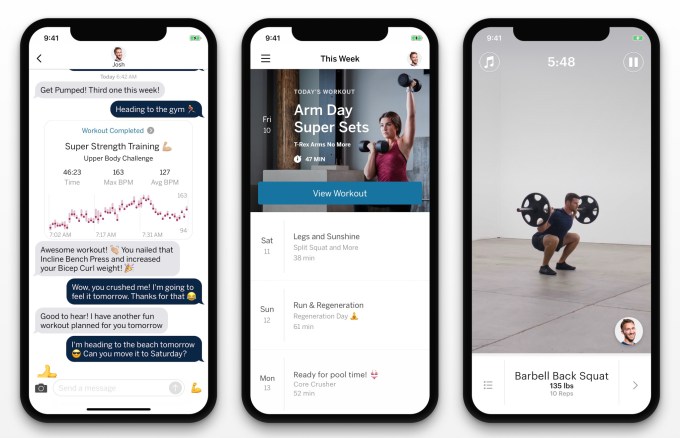
Apple Fitness could be even more trouble for less premium apps like Sweat and Sworkit that provide basic visual guidance for workouts, or Aaptiv that’s restricted to just audio cues. Hardware startups like Peloton, which offers off-bike Beyond the Ride workouts with live or on-demand class, and Tempo’s giant 3D-sensing in-home screen for weight lifting, could also find casual customers picked off by a free or cheap alternative from Apple.
There’s no code indicating a payment mechanism, so Apple Fitness could be free. But it’s also easy to imagine Apple layering on a premium feature like remote personal training assistance from human experts or a wider array of exercises for a fee, tying into its increasing focus on services revenue.
Wallpapers – access for third-parties
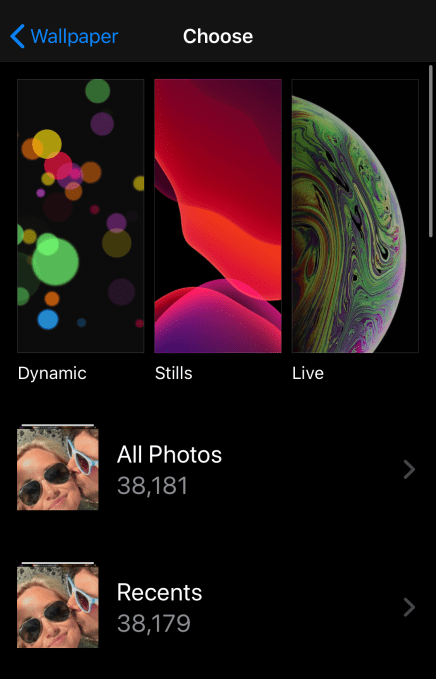
The iPhone’s current wallpaper selector
In iOS 14, it appears that Apple will offer new categorizations for wallpapers beyond the existing Dynamic (slowly shifting), Still and Live (move when touched) options. Apple’s always only offered a few native wallpapers plus the option to pull one from your camera roll. But the iOS 14 code suggests Apple may open this up to third-party providers.
A wallpaper “store” could be both a blessing and a curse for entrepreneurs in the space. It could endanger sites and apps like Vellum, Unsplash, Clarity, WLPPR and Walli that aggregate wallpapers for browsing, purchase or download. Instead, Apple could make itself the ultimate aggregator by being built directly into the wallpaper settings. But for creators of beautiful wallpaper images, iOS 14 could potentially offer a new distribution method where their collections could be available straight from where users install their phone backgrounds.
The big question will be whether Apple merely works with a few providers to add wallpaper packs for free, does financially backed deals to bring in providers or creates a full-blown marketplace for wallpapers where creators can sell their imagery like developers do apps. By turning this formerly free feature into a marketplace, Apple could also start earning a cut of sales to add to its services revenue.

AirTags – find your stuff
Apple appears to be getting closer to launching its long-awaited AirTags, based on iOS 14 code snippets. These small tracking tags could be attached to your wallet, keys, gadgets or other important or easily lost items, and then located using the iOS Find My app. AirTags may be powered by removable coin-shaped batteries, according to MacRumors.

Native integration with iOS could make AirTags super-easy to set up. They also could benefit from the ubiquity of Apple devices, as the company could let the crowd help find your stuff by allowing AirTags to piggyback on the connectivity of any of its phones, tablets or laptops to send you the missing item’s coordinates.
Most obviously, AirTags could become a powerful competitor to the vertical’s long-standing frontrunner, Tile. The $104 million-funded startup sells $20 to $35 tracking tags that locate devices from 150 to 400 feet away. It also sells a $30 per year subscription for free battery replacements and 30-day location history. Other players in the space include Chipolo, Orbit and MYNT.
![]()
But as we saw with the launch of AirPods, Apple’s design expertise and native iOS integrations can allow its products to leapfrog what’s in the market. If AirTags get proprietary access to the iPhone’s Bluetooth and other connectivity hardware, and if they’re quicker to set up, Apple fans might jump from startups to these new devices. Apple also could develop a similar premium subscription for battery or full AirTag replacements, as well as bonus tracking features.
Augmented reality scanning – Codename: Gobi
iOS 14 includes code for a new augmented reality feature that lets users scan places or potentially items in the real world to pull up helpful information. The code indicates Apple is testing the feature, codenamed Gobi, at Apple Stores and Starbucks to let users see product, pricing and comparison info, according to 9To5Mac’s Benjamin Mayo. Gobi can recognize QR-style codes for specific locations like a certain shop, triggering a companion augmented reality experience.

It appears that an SDK would allow partners to build their own AR offerings and generate the QR codes that initiate them. Eventually, these capabilities could be extended from Apple’s mobile devices to the AR headset it’s working on so you’d instantly get a heads-up display of information when you entered the right place.
Apple moving to power lighter-weight AR experiences rather than just offering the AR Kit infrastructure for developers to build full-fledged apps could create competition for a range of startups and other tech giants. The whole point of augmented reality is that it’s convenient to explore hidden experiences in the real world, which is defeated if users have to know to download and then wait to install a different app for every place or product. Creating a central AR app for simpler experiences that load instantly could speed up adoption.
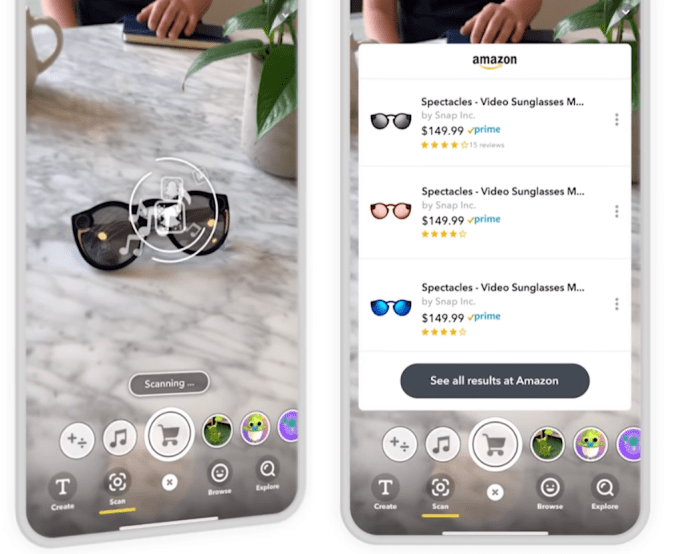
Snapchat’s Scan AR platform
Startups like Blippar have been working on AR scanning for years in hopes of making consumer packaged goods or retail locations come alive. But again, the need to download a separate app and remember to use it has kept these experiences out of the mainstream. Snapchat’s Scan platform can similarly trigger AR effects based on specific items from a more popular app. And teasers of Facebook and Google’s eventual augmented reality hardware and software hinge on adding utility to every day life.
If Apple can build this technology into everyone’s iPhone cameras, it could surmount one of AR’s biggest distribution challenges. That might help it build out a developer ecosystem and train customers to seek out AR so they’re all ready when its AR glasses finally arrive.
Powered by WPeMatico


